Displaying items by tag: Cruising
Howth Harbour
Howth Harbour
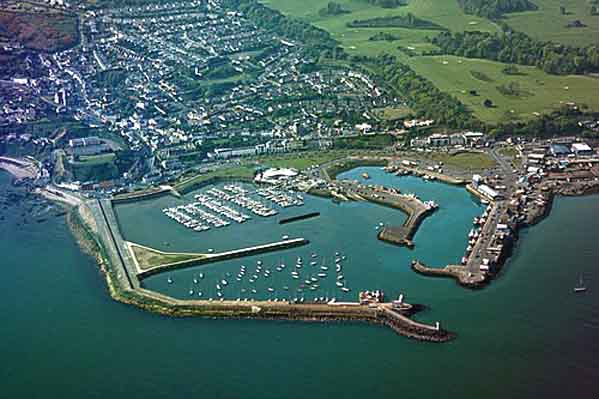
A picturesque fishing village nestled on the rugged peninsula that forms the north side of Dublin Bay, Howth is one of Ireland’s many hidden treasures. That is not to say that the village doesn’t receive its fair share of visitors. Far from it. Howth is a favourite holiday destination and benefits especially from its popularity amongst yachtsmen and pleasure boaters. Indeed Howth Yacht Club dates back to 1895 and with around 2,000 members it is by far the largest in the country and enjoys a busy programme of racing, regattas and voyaging. The marina and club complex combine state of the art with old and traditional with standards of services superb across the board. As you would expect from such a large club, berths are plentiful and marine services top notch.
Away from the harbour itself there is much to recommend Howth. Historians will love the ruined abbey, nearby Baily Lighthouse and 15th century castle. You can take a bracing stroll along the piers, sight-see aboard an open top tram, watch seals and dolphins in the waters along the shore and take in breathtaking views from cliff top walks. Of course, Howth’s working fishing port means that fish and seafood lovers are absolutely spoilt when it comes to dining out and the pub scene is second only to Dublin itself, if a little more relaxing.
Howth is a lovely place from which to discover Ireland. You can blow away the cobwebs and kick back and explore the magnificent coastline at your leisure knowing you will be returning after each trip to one of the friendliest places on earth. And that’s the truth.
Marine Services in Howth – click here
Pilot Notes for Howth – click here
Marinas in Howth – click here
Accommodation in Howth – click here
Emergency
Fire/Ambulance/Police: 999/112
Customs: 874 6571
Harbour Master: 83 222 52
Lifeboat: 8323 524
Beaumont Hospital: 83 777 55
Tourist Information – Fingal Tourist Information Office +353 1839 6955
Air Travel
Aer Lingus: 705 3333
British Midland: 283 8833
RyanAir Flight Information: 1550 200200
CityJet: 844 5566
Car Ferries
Stena Line: 204 7777
Irish Ferries: 66 10 511
Rail Transport – Iarnrod Eireann (Irish Rail): 83 66 222
Howth Harbour Harbour Master's Office – Captain Raja Maitra, tel +353 (0) 1 83 222 52 or mobile 086 3814926. fax +353 (0) 1 832 6948 (Office situated Northern End of Auction Hall)
Waterford Motorboat and Yacht Club
Waterford Motorboat and Yacht Club
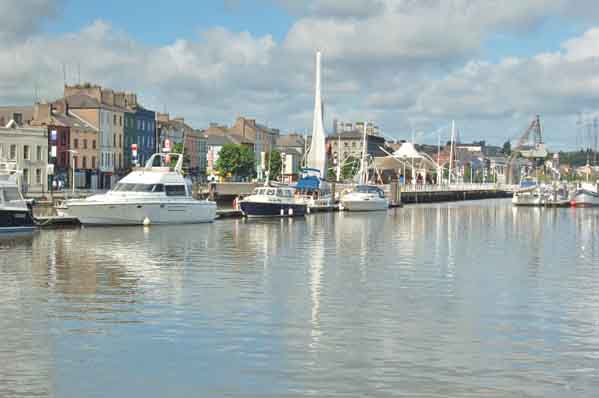 WMYC was formed in 1996 and is based at Waterford City Marina, in the south east of Ireland. Its principal activities include cruising in company: River Nore, Barrow and Suir, Waterford estuary, and the South and East Coasts of Ireland. Autumn League sailing races are held over five weekends during September/October each year. Other on-the-water activities include predicted log, duck races and boat handling competitions. There are also various social events held on dry land throughout the year.
WMYC was formed in 1996 and is based at Waterford City Marina, in the south east of Ireland. Its principal activities include cruising in company: River Nore, Barrow and Suir, Waterford estuary, and the South and East Coasts of Ireland. Autumn League sailing races are held over five weekends during September/October each year. Other on-the-water activities include predicted log, duck races and boat handling competitions. There are also various social events held on dry land throughout the year.
Waterford Motorboat and Yacht Club, Waterford Cit. Contact: Ena Phelan, Knockroe, Passage East, Co. Waterford. Tel and Fax: 051 382 767, email: [email protected]
Have we got your club details? Click here to get involved
Sailing and Boating Holidays in Ireland
Whether you want to learn to sail, are already an experienced sailor and want to cruise the canals, or feel like touring around the coast, our Island of Ireland can accommodate you.
PAGE UNDER CONSTRUCTION ;-)
Winterising Your Boat
Winterising Your Boat
The whole idea of winterisation can be about as appealing as having a tooth filled – and possibly as expensive – but there’s no substitute for being prepared, and a reluctance to cough up the necessary budget can be a false economy in the long run.
Of course, winterisation is not a word that will stir much enthusiasm in the breast of the average boat-owner, bringing home the fact that summer is over and the evenings will now close in with unprecedented speed.
However, the W-word could be quite painless, even fun, if you are into that sort of thing. And most sailors love their boats – it being a source of pride and pleasure – and want to keep them in top condition.
This Afloat guide to winterising your boat (see menu on right hand side of page) will steer you towards those who can do the job for you, or at least give you useful advice so that you don’t end up standing in the dark, cold, wet, and frustrated, with oil on your clothes and an engine strewn all over the driveway.
It may be true that in the depths of winter lies an invincible summer.
Sailing in Dublin Club (SID)
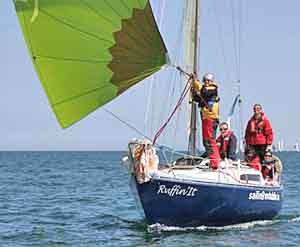 Ruffin'It taking part in the 2008 Lambay Race, June 2008. Standing: Martina, Peter and Daniel, and sitting: Carlos and Mags
Ruffin'It taking part in the 2008 Lambay Race, June 2008. Standing: Martina, Peter and Daniel, and sitting: Carlos and Mags
Sailing In Dublin Club (SID)
Sailing in Dublin Club (SID) is a small friendly club based in Dun Laoghaire, Co. Dublin.
Founded thirty years ago, the Club offers the opportunity of sailing regularly without having
to buy a boat. SID provides a fleet of dinghies and three yachts for sailing activities -
including racing and cruising – for a very competitive and affordable membership
subscription fee. The club welcomes adults who wish to enjoy sailing in Dublin Bay and
beyond.
If you are a beginner, you can sail on the club's 33ft Sigma and 23ft Ruffian keelboats with
experienced crew to build up your sailing skills and knowledge. If you have some sailing
experience, you can spend more time on the water dinghy sailing, on SID's 35ft cruising boat
Silver Wind, or on our keelboats where you can take part in all aspects of sailing, from
crewing to helming to navigation. SID gives you the opportunity of sailing with more
experienced sailors to build on sail training courses you may have taken elsewhere, or
perhaps before committing yourself to buying a boat.
Along with day sails in Dublin Bay and cruises further afield, all members are encouraged to
take part in races and regattas held in Dun Laoghaire during the summer months and the
'frostbite' series held on Sundays during the winter. Reflective of the club's voluntary ethos,
members take part in all aspects of running and organising the club and help with boat
maintenance. Boats, rescue cover and safety equipment are provided. Guest sails with the
club are available for those wishing to see what the club has to offer before joining as a full
member. The cost of a guest sail is redeemable against the full membership fee.
Regular weekend dinghy and yacht day sails and races continue over winter months subject
to suitable weather conditions. Club members are also encouraged to up-skill by
participating in on-shore training courses, attending talks. There are also opportunities for
socialising after sails as well as through Club dinners and other social events.
Club membership runs from January 1st to December 31st. In 2015 the annual membership
fee is €370. For details of any special offers throughout the year keep an eye on the Club's
website.
Further information on Sailing in Dublin Club and details of how to join can be found by
going to www.sailingindublin.ie or by contacting the SID Membership Secretary, Email:
www.facebook.com/sailingindublin
Lough Swilly Yacht Club
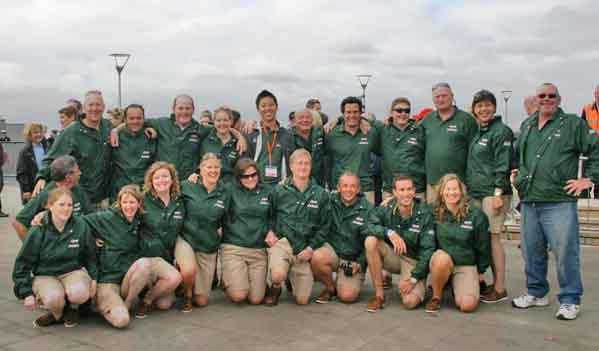
Above: the crew of Cork at the beginning of the Clipper Race 2009
Lough Swilly Yacht Club
Lough Swilly Yacht Club is based in Fahan Creek on the shores of Lough Swilly, Co Donegal, three miles from Buncrana and ten miles from Derry.
Our membership consists of IRC-racing and cruising sailors as well as powerboat enthusiasts and some keen dinghy sailors. All club members enjoy spending time pottering about on the lough and many like to venture further afield; either to cruise or to represent the club in competition (see the Ships' Blog section for more).
Club History
The Lough Swilly Yacht Club was founded in February, 1955, when a meeting took place in the old City Hotel, with a view to forming a 'club' to encourage sailing and power boating in Lough Swilly by every possible means.
The first Officers of the club were: Commodore Dr. T.E. Hastings. Vice Commodore James McColgan. Rear Commodore Stephen Faller. Secretary Mayne Elliot and Treasurer Norvall Watt. A Committee was set up of men who between them had a wealth of sailing experience and whose enthusiasm and sheer hard work laid the firm foundation of today's thriving club.
The club was fortunate to have as a founder member Mr. James Whyte, Manager of the Lough Swilly Railway Co. and when the railway line from Derry to Buncrana closed in 1953 the club was able to purchase for a very nominal sum the old station waiting room and ticket office, as well as a considerable amount of ground where the old railway line ran beside the water's edge. This formed the nucleus of the present club and in subsequent years the slipway was built and extended, the caravan site erected and the clubhouse itself took in the old station house.
The first racing took place at 3.30pm (Swilly time) on Opening Day, Saturday 2nd July 1955, and there was a fine turnout of miscellaneous craft. After the day's racing all members and friends were invited to afternoon tea at the temporary club premises on the Railway Station Platform in Fanad, durning which prizes were awarded.
(The above information and image courtesy of Lough Swilly Yacht Club.
Lough Swilly Yacht Club, c/o Karen Sleat, Fahan, Lifford, Co Donegal. Email: [email protected]
Garrykennedy Sailing Club
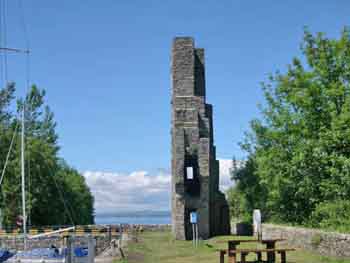
Garrykennedy Sailing Club
Garrykennedy Sailing Club was founded in The Barge Inn, Garrykennedy (now Larkins) in the first week of September 1985. The subscription was set at £5 and twenty people became members. Willie McGrath was the first Commodore. The first series prize was donated to the club by Joe Reynolds in memory of the late Eddie Regan and was sailed for in October of that year. The boats sailing ranged in length from 17ft to Jubilee B at 33ft. During that series there were about 12 boats in the fleet.
Left: Garrykennedy Castle
(The above information and image courtesy of Garrykennedy Sailing Club)
Garrykennedy Sailing Club c/o Jim Hughes, Garrykennedy, Portroe, Nenagh, Co Tipperary. Tel: 067 23001, email: [email protected]
Have we got your club details? Click here to get involved
Foynes Yacht Club
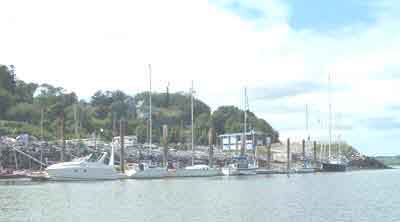
Foynes Yacht Club
Foynes Yacht Club was founded in 1962, it has a modern club house with good facilities, bar, showers, changing rooms, kitchen and dance floor. Floating pontoons and deep water moorings allow ease of access to boats at all stages of the tide. Racing every Wednesday evening during the season. Membership is open to all, and Juniors are especially welcome.
Foynes Yacht Club – Its settings and origins – by R.J. Scott, 1991
In the age of commercial sail right up to the 1914–18 War, the Shannon Estuary was used regularly by coasting schooners and the like. Records show a considerable use of quays at Kilrush, Foynes, Kiladysert by these fine old wooden vessels. In fact, the Clare river (Fergus) was worked right up to Clarecastle in schooners and brigantines carrying as much as 320 tons of coal on 12.5 ft. draft, and that often without power other than flax, wind, a damn good kedge anchor and an even better six-man crew! Within the Estuary, as recently as 1954, the final cargo under sail was carried from Limerick when the late Johnny Davis put his 25-ton cutter Alzina on the mud at Labasheeda for the last time. Today motor craft have taken over from seagoing sail, fewer but bigger, and the lower Shannon sees them in all shapes of increasing ugliness, from 500 to 170,000 tons. In an age where carrying capacity is god and aesthetic beauty of line no longer of value in complex Balance Sheets, estuary craft like the Alzina, Edgar, Lahloo, Baron Joss, Mary Joseph and others have surrendered to the economics of road transport.
The traditions of sail have been passed on and nurtured to a degree by yachtsmen the world over. Yet strangely, the Shannon Estuary appeared to lose much of this contact, that is apart from a comparatively few individuals, hardly more than a dozen or two at one time between 1920 and 1962. Perhaps the best known figure of this era was the late Conor O'Brien of Foynes who, fifty years ago this year (1991), sailed round to Dublin and took his departure on 23rd June in his 20-ton Baltimore-built ketch Saoirse. Exactly two years later to the day, he arrived back to a massive welcome having circumnavigated the world. His craft was the first to carry the new Irish tricolour round the globe. Conor's writings are widely read and his home may still be seen, set amongst the trees on Foynes Island.
It was inevitable, of course, that with the increasing popularity of yachting on other coasts the pastime should develop in the Estuary. In July, 1962 seven boat-owners, five from Limerick, one from Foynes and one from Newcastle West,got together in a Foynes local and simply formed a club. So Foynes Yacht Club was born. For the record, the seven founders were: Dan O'Sullivan (Commodore), Dick Nash (Secretary), Peter Lawless (Treasurer) with Peter McKenna, Pat Dinneen, Joe Bottcher and Roger Bourke.
From this small beginning Foynes Yacht Club had grown to a membership of one hundred and eighty by 1973. That year marked a long sought milestone, the opening of the new clubhouse. With it's 250ft boat slip built by members in 1971, it gave Foynes and the lower Shannon Region it's first major water based leisure facility.
Coincidentally, the West of Ireland Offshore Racing Association's Annual Championship for Cruisers, also established 1973, has been hosted successfully every third year by the club since then.
Dublin Bay Mermaids were very popular in the club during the early seventies, declined almost to extinction in the eighties, but have returned more popular than ever in the nineties. But, if the Mermaids numbers declined, interest by Mermaiders in Foynes didn't and the Mermaid National Championship was hosted by the club in 1973, 1977, 1984 and 1989 and is again scheduled for 1993. Meanwhile the club instituted The Munster Mermaid Championship in 1990 as an annual event which even attracts boats from the east coast to participate.
Perhaps the busiest year for the club was 1989 when it hosted a GP14 Championship in May, the West of lreland Offshore championship in July, the Mermaid Nationals in August and then revived the town Regatta in September. The club continued to improve by developing its facilities, reclaiming and rockfacing the foreshore, extending and paving the dinghy and car parks and widening the slipway. The Club constructed the first Marina on the west coast, a development which is being considerably extended and improved this year. Plans are also in hand to improve the clubhouse.
And today's club...
The river Shannon is the longest river in the British isles. It rises in Co Cavan and enters the Atlantic ocean in the southwest of Ireland. It is tidal west of Limerick city. It's estuary has a tidal range of over 5 metres and it can run at over 4 knots in places.
Foynes is located in the southwest of Ireland on the southern shore of the Shannon estuary on a channel formed by Foynes Island. It has a very busy commercial port and to the west of this Foynes Yacht club. It is about 25 miles west of Limerick city on the N69.
In the club there are about 12 yacht over 9 metres, eight in the 7–9 metre range and about ten active mermaids plus other dinghies. We race every Wednesday evening during the summer months and on Sundays in September as well as some annual weekend events. In all there are just over 130 members.
Our facilities include a modern clubhouse with bar, dance floor, toilets and showers.
We have a pontoon which can accommodate approximately eight visiting boats, four club boats, the club crashboat and 12 dinghies.
All other boats are kept on swinging moorings on the east side of Foynes island. Additionally there is a wintering compound for 30 yachts and a launching slip.
(The above information and image courtesy of Foynes Yacht Club)
Foynes Yacht Club, Cooleen Point, Foynes, Co. Limerick. Tel 353 62 65261
or
c/o Elaine O' Mahoney, Coolen Point, Foynes, Co Limerick. Tel: 069 65261, email: [email protected]
Have we got your club details? Click here to get involved
Dungarvan Harbour Sailing Club

Dungarvan Harbour Sailing Club
Dungarvan has always been noted for its sailors and its great sea-faring families and the tradition of the bygone days of the coastal schooners is reflected there today in the strong active sailing club which was founded at a public meeting in the Town Hall on Friday 2nd August 1946. The first officers were Bernard Mulcahy, Commodore, Reveille Farrell, Vice Commodore, Maurice Kiely, Secretary and Joe Donovan, Treasurer.
Left: The Clubhouse
The inaugural race of the club, for the newly presented Mulcahy Cup, was held over a 6½ mile course with a fleet of four boats; Mairead built by Tyrells and owned by Bernard Mulcahy, Maise formerly of Dublin owned by Maurice and Peter Kiely, Naomh Breandáin owned by Gerard Walsh, and Jane Shore owned by James Villiers Stuart. The race was won by Maurice and Peter Kiely.
Helvick based boats then showed an interest and these craft, mostly gaff rigged salmon boats crewed by fishermen from the Helvick and Ring Gaeltacht, were usually well placed. Amongst these 'Pauls Boat' and 'Slatterys Boat' were outstanding, leaving the 'yachts' a poor second on more than one occasion.
In 1948 Reveille Farrell bought Susanna, a nine-ton Bermudan cutter designed by Norman Dallimore and built in 1936. She was to become well known for her many cruises to the West Coast of Ireland, in the English Channel, and Brittany. The most famous of these was in June 1957 when accompanied by Gerard Walsh and John Ballot she sailed to Spain and back. This was a considerable achievement at the time as it was believed that the passage across the Bay of Biscay and back again was beyond the capacity of the average cruising yacht in the normal holiday period. Coincidental with the arrival of “Susanna” some of the older boats changed hands and were lost to the club and big boat racing activity declined. They were replaced by a number of one man canvas sailing canoes, owned and frequently capsized by Col. Jack Hockin, Maurice Kiely, and Tim MacCarthy – which were the beginnings of dinghy sailing in Dungarvan Harbour.
During the winter of 1958, John and Austin Flynn built a 16’ hard chine Petrel class dinghy from plans in an American magazine. Because the design was ideally suited for home construction many Petrels quickly followed and dinghy sailing really became established in Dungarvan. There was great rivalry and competition in the fleet and each new boat came with a further refinement or new 'secret weapon' not seen on previous models. Construction methods changed from larch planking and cotton sails to plywood and terylene. In all 50 boats of the class are known to have been built, the later ones of GRP construction. An unfortunate drawback of the Petrel was the fact it was unique to Dungarvan and those interested in inter club competition had to look to other designs to compete nationally.
GP14s were popular for a while during which period the club hosted the Purcell trophy. Nowadays the dinghy fleet comprises of Wayfarers, Lasers, Mirrors and Toppers sailed by a very active junior section.
The cruiser fleet has also expanded and the burgee of DHSC has been carried far afield and its members have logged many miles from Cape Horn to the Northern Latitudes.
Although once a busy commercial port, Dungarvan in common with many other ports of its size suffered when changes in shipping practices led to a decline in the number of vessels using the port and with trade totally finished many of the old warehouses along the quayside became derelict. Reconstruction has injected new life into this area of the town and created the opportunity for Dungarvan Harbour Sailing Club to acquire a site on the quay front on which to build a clubhouse which is now the focal point of club activities.
The Town Council is currently progressing the construction of a marina, which together with the abundance of new restaurants and other onshore facilities available will firmly establish Dungarvan as a compulsory stopover for cruising yachts and greatly ease the current shortage of mooring space in the harbour.
DHSC is a family orientated club. Visitors by road and sea are welcome. Pontoons at quayside. Showers and toilets available in the Clubhouse to visitors. The Clubhouse and bar are open at the weekend from 5pm throughout the year, dinghy and cruiser racing and cruising in company during the summer.
(The above information and image courtesy of Dungarvan Harbour Sailing Club)
Dungarvan Harbour Sailing Club, c/o Andrew Corby, Davitt's Quay, Dungarvan, Co Waterford. Tel: 058 45663, email: [email protected]
Have we got your club details? Click here to get involved
Cumann Seoltóireachta An Spidéil

Cumann Seoltóireachta An Spidéil
Providing sailing to the children and adults of the area since 2003. Hosts an Annual CSS Dinghy Regatta
left: Early morning at Spiddal pier
Páirc báid ag Sean Céibh an Spidéil. Seoladh gach deire eachtain agus trathnóna amháin i rith na seachtaine. Failte faoi leith chuig daoine agus atá taithí seol acu. Cursaí sheoil ar fáil i rith an samhradh.
Cumann Seoltóireachta An Spidéil, or CSS, Cois n Tra, Coast Road, Spiddal Village, Co. Galway. Tel: 087 279 1095, email: [email protected]
or
Contact: Billy Keady, Stripe, Furbo, Co. Galway. Tel: 087 263 9308, email: [email protected]
Have we got your club details? Click here to get involved




























































